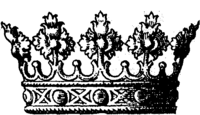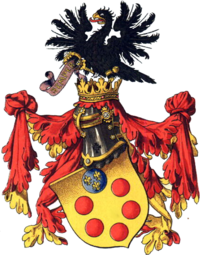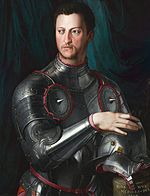- Duke of Florence
-
Il Duca di Firenze, rendered in English as The Duke of Florence, was a title created in 1532 by Pope Clement VII. There were effectively only two dukes, Alessandro de' Medici and Cosimo de' Medici, the second duke being elevated to The Grand Duke of Tuscany, causing the Florentine title to become subordinate to the greater Tuscan title.[1]
Contents
History
In 1532, Pope Clement VII, who was born Giulio di Giuliano de' Medici, appointed Alessandro de' Medici as duke over the Republic of Florence, the de' Medici family having acted as de facto rulers over the city of Florence since 1434. The duchy would bolster de' Medici power and influence in the region, which had just a few years prior been restored by Emperor Charles V & I after political upheaval against the de' Medici pope and de' Medici rulers of Florence in 1527. Alessandro is also believed by historians to have been the illegitimate son of either Pope Clement VII or Lorenzo II de' Medici, Duke of Urbino.[1][2]
In 1535, a delegation of Florentine nobles, which included the Pazzi family who previously conspired to assassinate Lorenzo de' Medici and was headed by Alessandro’s cousin Ippolito de' Medici, sought to gain the assistance of Emperor Charles V & I to depose Alessandro. Charles rejected the delegations’ appeals, as Alessandro had been wedded to the emperor's daughter Margaret of Parma.[1]
Alessandro ruled as duke less than four years, being assassinated by Lorenzino de' Medici on 6 January 1537. With no legitimate issue, Cosimo de' Medici was chosen to succeed his distant relative by Florentine officials. Cosimo completely overhauled the bureaucracy and administration of Florence, and, in 1542, the Imperial Armed Forces stationed in Florence by Charles V & I were withdrawn.[1]
On 17 April 1555, Florentine and Spanish forces occupied the Republic of Siena after a brief conflict. Philip II of Spain bestowed the territory on Cosimo as a hereditary fiefdom in July of 1557. In 1548, Cosimo purchased Elba from the Republic of Genoa and based his new developing navy there. Cosimo founded the port city of Livorno and allowed the city’s inhabitants to enjoy freedom of religion. The ducal family moved into the Palazzo Pitti in 1560. Cosimo commissioned the architect Vasari to build the Uffizi as offices for the de' Medici bank. Finally, Cosimo was elevated to The Grand Duke of Tuscany in 1569 by Pope Saint Pius V. This effectively ended the Duchy of Florence, which became subordinate to the more elevated grand ducal title. The de' Medici continued to rule over Florence and Tuscany until their extinction in 1737.[1]
The Dukes
Alessandro de' Medici
- Birth: 22 July 1510
- Death: 6 January 1537
- Reign: 1532 – 6 January 1537
- Created the first Duke of Florence in 1532 and reigned until his assassination on 6 January 1537. Alessandro died without legitimate issue, causing Florentine officials to select the next duke.
- Birth: 15 June 1519
- Death: 21 April 1574
- Reign: 1537 – 1574
- Selected to succeed as second Duke of Florence in 1537, reigning until his abdication in early 1574 in favour of his son, Francesco I de' Medici. From 1569 on, he was known as Cosimo I and created the first Grand Duke of Tuscany, which became the ruling title used by his successors.
See also
- Duchy of Florence, for the ducal state itself
- Grand Duchy of Tuscany, for the state which succeeded the duchy
- Grand Duke of Tuscany, for the successor title
- House of Medici, for the noble family to which the dukes belonged
- Republic of Florence, the state which preceded the duchy
- Rulers of Florence and Tuscany, a comprehensive list of rulers over the city and region
References
- ^ a b c d e Strathern, Paul. The Medici: Godfathers of the Renaissance. Vintage Publishers: London.
- ^ "Duke Alessandro de' Medici". Victoria and Albert Museum. http://www.vam.ac.uk/collections/periods_styles/medieval/Med_Ren_Features/hidden_histories/hidden_histories_africans/medici/index.html. Retrieved 17 May 2010.
Categories:- Italian noble titles
- Medici family
Wikimedia Foundation. 2010.




